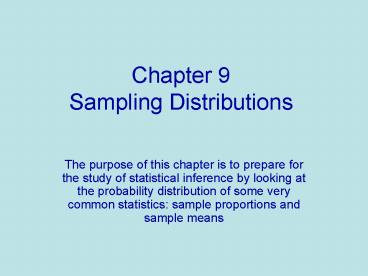Chapter 9 Sampling Distributions PowerPoint PPT Presentation
1 / 11
Title: Chapter 9 Sampling Distributions
1
Chapter 9Sampling Distributions
- The purpose of this chapter is to prepare for the
study of statistical inference by looking at the
probability distribution of some very common
statistics sample proportions and sample means
2
Parameter, Statistic
A parameter is a number that describes the
population. It is a fixed number, but in practice
we do not know its value because we cannot
examine the entire population. A statistic is a
number that describes a sample. The value of a
statistic is known when we have taken a sample,
but it can change from sample to sample. We
often use a statistic to estimate an unknown
parameter.
3
Remember statistics come from samples, and
parameters come from populations.
In data analysis, the distinction between
population and sample was not important. NOW,
it is essential. µ - mean of a population This
is a fixed parameter that is unknown when we use
a sample for inference. - mean of a sample
The average of the observations in the sample
4
The sample mean from a sample or an experiment
is an estimate of the mean µ of the underlying
population. Sampling variability the value of a
statistic varies in repeated random sampling.
5
A random sample of 515 US adults were asked if
they believed in ghosts. 160 responded yes.
So the proportion of the sample who said yes
is 0.31 is a statistic represents a
population proportion (p hat) represents a
sample proportion
6
Sampling Distribution The sampling distribution
of a statistic is the distributing of values
taken by the statistic in all possible samples of
the same size from the same population. The
sampling distribution is the ideal pattern that
would emerge if we looked at all possible samples
of size x from our population.
7
- Describing sampling distribution
- The overall shape
- The center of the distribution
- The spread. If the spread is close to normal, we
can use standard deviation to describe spread. - Outliers or other important deviations from the
overall pattern.
8
(No Transcript)
9
(No Transcript)
10
Unbiased statistic A statistic used to estimate a
parameter is unbiased if the mean of its sampling
distribution is equal to the true value of the
parameter being estimated.
11
The variability of a statistic is described by
the spread of its sampling distribution. This
spread is determined by the sampling design and
the size of the sample. Larger samples give
smaller spread. As long as the population is
much larger than the sample (say, at least 10
times as large), the spread of the sampling
distribution is approximately the same for any
population size.

